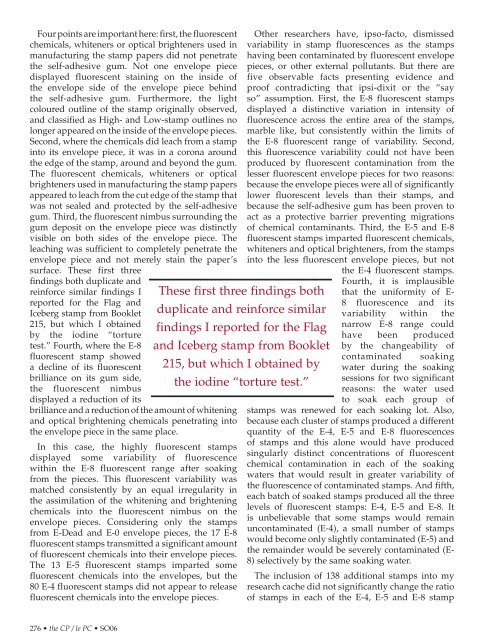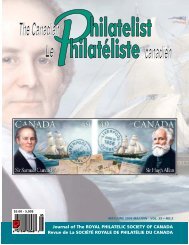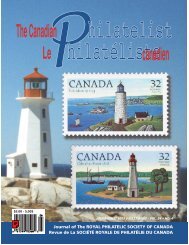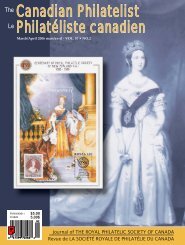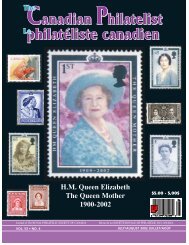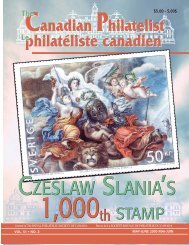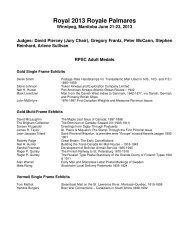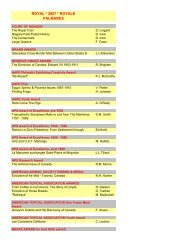Canadian Philatelist Philatéliste canadien - The Royal Philatelic ...
Canadian Philatelist Philatéliste canadien - The Royal Philatelic ...
Canadian Philatelist Philatéliste canadien - The Royal Philatelic ...
Create successful ePaper yourself
Turn your PDF publications into a flip-book with our unique Google optimized e-Paper software.
Four points are important here: first, the fluorescent<br />
chemicals, whiteners or optical brighteners used in<br />
manufacturing the stamp papers did not penetrate<br />
the self-adhesive gum. Not one envelope piece<br />
displayed fluorescent staining on the inside of<br />
the envelope side of the envelope piece behind<br />
the self-adhesive gum. Furthermore, the light<br />
coloured outline of the stamp originally observed,<br />
and classified as High- and Low-stamp outlines no<br />
longer appeared on the inside of the envelope pieces.<br />
Second, where the chemicals did leach from a stamp<br />
into its envelope piece, it was in a corona around<br />
the edge of the stamp, around and beyond the gum.<br />
<strong>The</strong> fluorescent chemicals, whiteners or optical<br />
brighteners used in manufacturing the stamp papers<br />
appeared to leach from the cut edge of the stamp that<br />
was not sealed and protected by the self-adhesive<br />
gum. Third, the fluorescent nimbus surrounding the<br />
gum deposit on the envelope piece was distinctly<br />
visible on both sides of the envelope piece. <strong>The</strong><br />
leaching was sufficient to completely penetrate the<br />
envelope piece and not merely stain the paper’s<br />
surface. <strong>The</strong>se first three<br />
findings both duplicate and<br />
reinforce similar findings I<br />
reported for the Flag and<br />
Iceberg stamp from Booklet<br />
215, but which I obtained<br />
by the iodine “torture<br />
test.” Fourth, where the E-8<br />
fluorescent stamp showed<br />
a decline of its fluorescent<br />
brilliance on its gum side,<br />
the fluorescent nimbus<br />
displayed a reduction of its<br />
brilliance and a reduction of the amount of whitening<br />
and optical brightening chemicals penetrating into<br />
the envelope piece in the same place.<br />
In this case, the highly fluorescent stamps<br />
displayed some variability of fluorescence<br />
within the E-8 fluorescent range after soaking<br />
from the pieces. This fluorescent variability was<br />
matched consistently by an equal irregularity in<br />
the assimilation of the whitening and brightening<br />
chemicals into the fluorescent nimbus on the<br />
envelope pieces. Considering only the stamps<br />
from E-Dead and E-0 envelope pieces, the 17 E-8<br />
fluorescent stamps transmitted a significant amount<br />
of fluorescent chemicals into their envelope pieces.<br />
<strong>The</strong> 13 E-5 fluorescent stamps imparted some<br />
fluorescent chemicals into the envelopes, but the<br />
80 E-4 fluorescent stamps did not appear to release<br />
fluorescent chemicals into the envelope pieces.<br />
<strong>The</strong>se first three findings both<br />
duplicate and reinforce similar<br />
findings I reported for the Flag<br />
and Iceberg stamp from Booklet<br />
215, but which I obtained by<br />
the iodine “torture test.”<br />
Other researchers have, ipso-facto, dismissed<br />
variability in stamp fluorescences as the stamps<br />
having been contaminated by fluorescent envelope<br />
pieces, or other external pollutants. But there are<br />
five observable facts presenting evidence and<br />
proof contradicting that ipsi-dixit or the “say<br />
so” assumption. First, the E-8 fluorescent stamps<br />
displayed a distinctive variation in intensity of<br />
fluorescence across the entire area of the stamps,<br />
marble like, but consistently within the limits of<br />
the E-8 fluorescent range of variability. Second,<br />
this fluorescence variability could not have been<br />
produced by fluorescent contamination from the<br />
lesser fluorescent envelope pieces for two reasons:<br />
because the envelope pieces were all of significantly<br />
lower fluorescent levels than their stamps, and<br />
because the self-adhesive gum has been proven to<br />
act as a protective barrier preventing migrations<br />
of chemical contaminants. Third, the E-5 and E-8<br />
fluorescent stamps imparted fluorescent chemicals,<br />
whiteners and optical brighteners, from the stamps<br />
into the less fluorescent envelope pieces, but not<br />
the E-4 fluorescent stamps.<br />
Fourth, it is implausible<br />
that the uniformity of E-<br />
8 fluorescence and its<br />
variability within the<br />
narrow E-8 range could<br />
have been produced<br />
by the changeability of<br />
contaminated soaking<br />
water during the soaking<br />
sessions for two significant<br />
reasons: the water used<br />
to soak each group of<br />
stamps was renewed for each soaking lot. Also,<br />
because each cluster of stamps produced a different<br />
quantity of the E-4, E-5 and E-8 fluorescences<br />
of stamps and this alone would have produced<br />
singularly distinct concentrations of fluorescent<br />
chemical contamination in each of the soaking<br />
waters that would result in greater variability of<br />
the fluorescence of contaminated stamps. And fifth,<br />
each batch of soaked stamps produced all the three<br />
levels of fluorescent stamps: E-4, E-5 and E-8. It<br />
is unbelievable that some stamps would remain<br />
uncontaminated (E-4), a small number of stamps<br />
would become only slightly contaminated (E-5) and<br />
the remainder would be severely contaminated (E-<br />
8) selectively by the same soaking water.<br />
<strong>The</strong> inclusion of 138 additional stamps into my<br />
research cache did not significantly change the ratio<br />
of stamps in each of the E-4, E-5 and E-8 stamp<br />
276 • the CP / le PC • SO06


